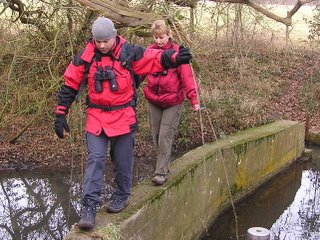Readers of this Blog may have noticed the importance of lists. Birders are inveterate - even compulsive - list builders. Lists may comprise birds seen in one's life; in one's country; in one's county, district, garden, local patch; during a day, a holiday, or even walking to work. They don't even have to be written down: a "Birds seen on the train to London" list might contain only 2 or 3 species (e.g. swan and crow). I have a Millennium List that I started on 1 January 2000 and is still going. I once had a "Birds Seen while Having a Pee List", started when a group of Whooper Swans flew past as I was paying my respects to the River Dyfi and it seemed a good species to start off a new list with. But I gave it up when it began playing hell with my Bladder Evacuation Reflex (BER).
At the extreme, list-builders can become obsessive and aggressive, when miles can be travelled over a weekend to add another "tick" to overtake a rival birder's tally. There is a 100% authenticated case of a birder wrenching himself from the comfort of his new bride's arms and the warmth of the nuptial bed in order to respond to his pager for just this purpose ("You'll be here tomorrow, dear, the Terek Sandpiper might not be"). These compulsive list-builders are the "twitchers" - so called because of the neurotic twitching spasms that may be induced by the prospect of missing a tick ("dipping out").
Do lists have ornithological value? Well, yes, they can. At the very least they are documentation that something was present at a certain place at a certain time. Include the number seen, do it at regular intervals at the same site and it can become a valuable historical record of avian biodiversity. But of course there is more to it than that. There is no doubt a sublimation of the "collection instinct": if it's OK to collect stamps or train numbers, then why not lists of birds identified? So there is an undeniable recreational angle and, if not too obsessive, it's a harmless hobby and great fun.
I believe there is even more to it than that, however. It keeps one alert and aware. You never stop looking out of train windows, you notice more going on around you and it gives a
point to every holiday. Moreover, list building engenders discipline by making you look at everything, searching through a flock with a telescope, bird by bird, in case something unusual is amongst them (that's how I found my "lifer" today). And that "boring little brown thing" in a bush could turn a list of 99 into 100!
For most British birders, the most important lists are the UK Life List, the County List and the
Current Year List. I wasn't bothering with a "Year List" this year. Until
Pam told me she was on a ton. So out of curiosity I tallied up mine and it came to 96. This was outrageous. The brain kicked the male competitive spirit into gear and plans were made to at least rectify the deficit. The location selected for this task was Walney Island as I could think of a couple of certainties and, sure enough, despite being slightly foggy and the tide miles out, Greenshank and Eider were snapped up in a few minutes. Then a whirr of wings through the fog: Red-legged Partridge, admittedly of dubious provenance, but if it goes in the Observatory log book, then it's good enough for me. Then a splendid female Scaup on the oyster-farm pools brought a hundred up: job done!
Back at the Observatory, ringing friend Ken had arrived, and told me that a male American Wigeon had turned up across the Bay near Cavendish Dock, consorting with European Wigeon and had been showing well at high tides during the week. Wow! That would be a LIFER! So it was back across the bridge to the mainland in pursuit of the said duck. Now, might this be described as "twitching"? Not necessarily. I was out birding anyway, the location was on my routine local birding circuit and only a small deviation from my route home anyway. So, acceptable birding - definitely 'fair game'.
I found the Wigeon flock in question, and started going through the birds one by one, moving along the coastal path, group by group as they fed along the tide line. Patience was rewarded and I obtained splendid views of this American cousin! Now to up-date my lists - it goes on at least four!
Sunday 5th February - back at SilecroftThere's only one word that can describe Silecroft this afternoon -
bleak. A light but steady cold moisture-laden wind was blowing off the Irish Sea, generating moderate surf. At least there was one advantage - a lack of
people. Most of those who had ventured out stayed in the comfort of their cars, and those who did get out kept walking. But three hours of fishing (two rods, four hooks) produced not a single bite. Ho hum. Come the Revolution and I'll not even be able to count on flounder cakes.
Back home I made an apple pie. Then I remembered I had a bowl of Chinese butter lurking in the fridge. Two puddings - yippee!




